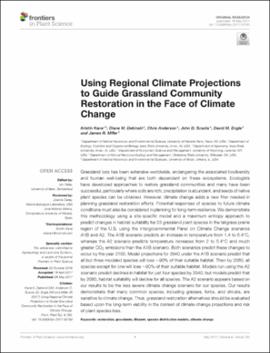| dc.contributor.author | Kane, Kristin | |
| dc.contributor.author | Debinski, Diane M. | |
| dc.contributor.author | Anderson, Chris | |
| dc.contributor.author | Scasta, John D. | |
| dc.contributor.author | Engle, David M. | |
| dc.contributor.author | Miller, James R. | |
| dc.date.accessioned | 2019-09-25T18:24:37Z | |
| dc.date.available | 2019-09-25T18:24:37Z | |
| dc.date.issued | 2017-05-09 | |
| dc.identifier | oksd_kane_usingregionalcl_2017 | |
| dc.identifier.citation | Kane, K., Debinski, D. M., Anderson, C., Scasta, J. D., Engle, D. M., & Miller, J. R. (2017). Using regional climate projections to guide grassland community restoration in the face of climate change. Frontiers in Plant Science, 8, Article 730. https://doi.org/10.3389/fpls.2017.00730 | |
| dc.identifier.uri | https://hdl.handle.net/11244/321426 | |
| dc.description.abstract | Grassland loss has been extensive worldwide, endangering the associated biodiversity and human well-being that are both dependent on these ecosystems. Ecologists have developed approaches to restore grassland communities and many have been successful, particularly where soils are rich, precipitation is abundant, and seeds of native plant species can be obtained. However, climate change adds a new filter needed in planning grassland restoration efforts. Potential responses of species to future climate conditions must also be considered in planning for long-term resilience. We demonstrate this methodology using a site-specific model and a maximum entropy approach to predict changes in habitat suitability for 33 grassland plant species in the tallgrass prairie region of the U.S. using the Intergovernmental Panel on Climate Change scenarios A1B and A2. The A1B scenario predicts an increase in temperature from 1.4 to 6.4°C, whereas the A2 scenario predicts temperature increases from 2 to 5.4°C and much greater CO2 emissions than the A1B scenario. Both scenarios predict these changes to occur by the year 2100. Model projections for 2040 under the A1B scenario predict that all but three modeled species will lose ~90% of their suitable habitat. Then by 2080, all species except for one will lose ~90% of their suitable habitat. Models run using the A2 scenario predict declines in habitat for just four species by 2040, but models predict that by 2080, habitat suitability will decline for all species. The A2 scenario appears based on our results to be the less severe climate change scenario for our species. Our results demonstrate that many common species, including grasses, forbs, and shrubs, are sensitive to climate change. Thus, grassland restoration alternatives should be evaluated based upon the long-term viability in the context of climate change projections and risk of plant species loss. | |
| dc.format | application/pdf | |
| dc.language | en_US | |
| dc.publisher | Frontiers Media | |
| dc.rights | This material has been previously published. In the Oklahoma State University Library's institutional repository this version is made available through the open access principles and the terms of agreement/consent between the author(s) and the publisher. The permission policy on the use, reproduction or distribution of the material falls under fair use for educational, scholarship, and research purposes. Contact Digital Resources and Discovery Services at lib-dls@okstate.edu or 405-744-9161 for further information. | |
| dc.title | Using regional climate projections to guide grassland community restoration in the face of climate change | |
| osu.filename | oksd_kane_usingregionalcl_2017.pdf | |
| dc.description.peerreview | Peer reviewed | |
| dc.identifier.doi | 10.3389/fpls.2017.00730 | |
| dc.description.department | Natural Resource Ecology and Management | |
| dc.type.genre | Article | |
| dc.type.material | Text | |
| dc.subject.keywords | restoration | |
| dc.subject.keywords | grasslands | |
| dc.subject.keywords | maxent | |
| dc.subject.keywords | species distribution models | |
| dc.subject.keywords | climate change | |
